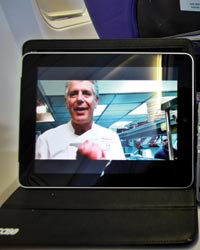Apple's iPad tablet has generated tremendous excitement among consumers all over the world, and airlines are taking notice.
Qantas Group's low-cost subsidiary Jetstar Airways made headlines in June when it announced plans to become the first airline to rent iPads as in-flight entertainment under a special partnership with portable IFE firm BlueBox and content service provider Stellar Inflight.
Following a short trial, Jetstar is looking to make iPads a regular part of its in-flight offering.
But Jetstar is not alone in its intention to turn the popular touchscreen computer into portable IFE. Carriers across the globe are studying their options for offering iPads to customers.
Malaysia Airlines, for example, plans to introduce iPads to passengers within the next six months
The carrier, under the direction of senior general manager, network, revenue management and distribution Amin Khan, was in the process of planning to install five iPads in its Kuala Lumpur ticketing office for use as booking kiosks when Khan saw Jetstar using the iPad for IFE and liked the idea.
|
|---|
Khan is also considering bringing iPads on board some of the airline's Boeing 737s.
But while the iPad as IFE is gaining in popularity, the devices are not expected to lead to the death of embedded IFE.
Malaysia, for example, does not intend to offer iPads on its Airbus A380s and additional A330s on order, as those will be delivered with embedded IFE systems. Indeed, most long-haul commercial aircraft on order today are earmarked to be fitted with installed IFE platforms.
"We love the iPad because it's changing people's expectations with regard picture quality, usability, capacitive touch and content navigation. We love that because that's driving us still harder to innovate with our [embedded IFE] monitors and functionality and everything else," says Neil James, executive director of corporate sales and marketing for IFE giant Panasonic Avionics.
"In terms of the iPad being IFE, if you're a carrier that operates a bunch of narrowbodies on short north-south routes but also flies long east-west routes, and surgically deploy a few entertainment devises on a fleet when required, there is an appeal for a handheld product. Whether the iPad is robust enough and whether it's customisable enough for airlines to adopt for their true cabin product as opposed to a stopgap until connectivity comes along or a different type of entertainment system comes along, is really hard to say."
Practicality is the driving reason cited by Khan for using the iPad as IFE on Malaysia's A330s. Installed IFE "is very, very expensive and maintenance is expensive too", notes Khan.
Providing the cheapest iPad for each of the 294 seats on a Malaysia A330-300 would cost $146,700 at list prices for the hardware.
The lack of in-seat power on Malaysia's A330s is a consideration, but Khan expects the iPad-equipped A330s to operate on routes shorter than the iPad's battery life, as long as passengers use the device to watch media.
Playing games will drain the battery faster. That's problematic because Khan believes games hold the greatest potential for the iPad. Games on built-in IFE systems are restricted to those that passengers can navigate with buttons.
Despite being a full-service carrier, Khan says Malaysia has not ruled out charging passengers a fee or deposit to use the iPad. He says one option could be for passengers to book an iPad with their ticket purchase.
"If we rent the iPad out and return your money on landing, I'm not sure how many people will take it. If we give it free the uptake is definitely 100%. Everyone will want the iPad. Literally everyone," Khan says.
The dilemma underpins Khan's biggest unresolved concern: security. "How do I make sure I get the iPad back? There must be a way to collect the iPad back after the flight."
Source: Flight International
























